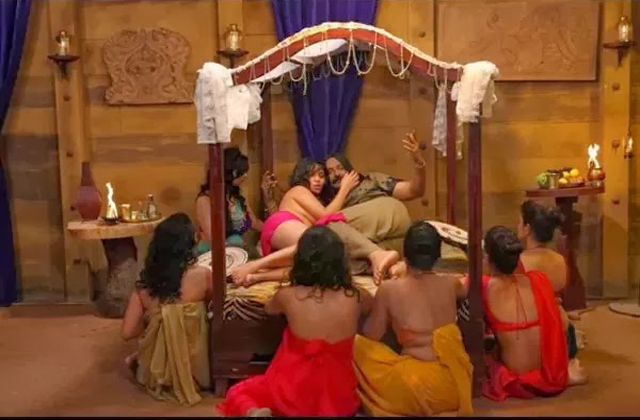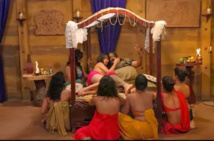The aim, says Indian curator Alka Pande, is to show "it is not a dirty little book and that it is not (just) a book on sexual positions."
"I want them to see it as a book of life, as a book of pleasure, as a book of celebrating the finer nuances of a great style of living and aesthetics," she told AFP.
The exhibit, at the Pinacotheque art gallery through January, "is not only erotic, it's about sensuality, it's about pleasure, it's all about music, dance, how to live a good life," she said.
With the City of Love in a saucy mood this season, the exhibit coincides with one on the infamous master of debauchery, the 18th-century Marquis de Sade, at the Musee d'Orsay, whose trailer shocked with its staged orgy of writhing naked bodies.
Some Parisians also got hot under the collar over a huge inflatable outdoor sculpture by American artist Paul McCarthy which, not unintentionally, resembled a sex toy.
And the Pinacotheque itself will open a new show next month, "The Art of Love in the Time of the Geishas", which like the Kama Sutra carries a warning that content may not be suitable for all.
One of the gallery's security guards told AFP that a few people, scandalised at images of acrobatic intercourse, orgies and even bestiality in the current show, had stormed out.
"They didn't take time to read the explanations," she shrugged.
- 'A boring little book' -
In reality, the better-known erotic side of the Kama Sutra is only one of seven tomes in a compilation by Vatsyayana, a member of the highest priestly class of Hindu society.
The Kama Sutra looks at the third of four pillars of Hinduism which correspond to the different stages of life. Having learned morals and ethics, and attained professional success, one can focus on Kama, or desire, not just sexually, but in drawing pleasure from the arts, music and the enjoyment of life.
"It's actually a boring little book otherwise, but I think when people wanted to illustrate it, it became like a pleasure book and ... nothing sells better than sex," said Pande.
"People don't know that it is seven books they just think: 'Oh my God, does a man stand on his head and have sex with six women at the same time'?"
Bathed in warm colours of saffron, green and purple, the exhibit takes viewers on a journey through the 36 chapters of the work, which looks at society and social concepts, how to find and woo a wife, even how to arrange household furniture.
The book suggests both men and women study the 64 arts, anything from how to make a bed to the art of war, magic, and teaching parrots to speak.
And in keeping with the propensity at the time for taking child brides, lists a girl who has "fully arrived at puberty" among those to be avoided in choosing a wife.
The book also details how to seduce the wives of others, and that most mysterious of pursuits: examination of the state of a woman's mind.
Images and sculptures of the gods Shiva and Parvati -- the idealised couple -- scenes of childbirth, and erotic reliefs often seen on ancient temples take their place beside objects of devotion, such as the phallic lingam.
Sculptures of women sneakily having sex with a man other than her husband, or a man with a courtesan, show the forward-thinking parts of a book that even mentions techniques of homosexual lovemaking.
- 'In India god makes love' -
Of course the famous depiction of yogic sexual positions abound, alongside pictures of sex with animals.
"In ancient Hinduism, the difference between man and animal was not as marked as in our culture. This is explained by the fact that a man could have been an animal in a previous life," read a note alongside the exhibit.
"There are some curious things here," said 92-year-old visitor Michelle. "In one of the cases... a woman and an elephant. Of course that makes you smile. The thing about the horse is quite curious too. But I suppose for them it was fun, religion aside."
Pande explains that in traditional India, sexuality was a way to view the world, and the Western guilt around eroticism made a work like the Kama-Sutra hard to understand.
"It has no concept of sin, it has no concept that you have sex only for procreation, it is really about celebrating the good life," she said.
This is also seen in the mythology surrounding Hindu's pantheon of gods, each of whom has a consort.
"If in Christianity God is love, in India god makes love. The better lover a god is, the better god he is," said Pinacotheque director Marc Restellini.
---------------------------------------------------------------------------------------------------------------------------------------------------
"I want them to see it as a book of life, as a book of pleasure, as a book of celebrating the finer nuances of a great style of living and aesthetics," she told AFP.
The exhibit, at the Pinacotheque art gallery through January, "is not only erotic, it's about sensuality, it's about pleasure, it's all about music, dance, how to live a good life," she said.
With the City of Love in a saucy mood this season, the exhibit coincides with one on the infamous master of debauchery, the 18th-century Marquis de Sade, at the Musee d'Orsay, whose trailer shocked with its staged orgy of writhing naked bodies.
Some Parisians also got hot under the collar over a huge inflatable outdoor sculpture by American artist Paul McCarthy which, not unintentionally, resembled a sex toy.
And the Pinacotheque itself will open a new show next month, "The Art of Love in the Time of the Geishas", which like the Kama Sutra carries a warning that content may not be suitable for all.
One of the gallery's security guards told AFP that a few people, scandalised at images of acrobatic intercourse, orgies and even bestiality in the current show, had stormed out.
"They didn't take time to read the explanations," she shrugged.
- 'A boring little book' -
In reality, the better-known erotic side of the Kama Sutra is only one of seven tomes in a compilation by Vatsyayana, a member of the highest priestly class of Hindu society.
The Kama Sutra looks at the third of four pillars of Hinduism which correspond to the different stages of life. Having learned morals and ethics, and attained professional success, one can focus on Kama, or desire, not just sexually, but in drawing pleasure from the arts, music and the enjoyment of life.
"It's actually a boring little book otherwise, but I think when people wanted to illustrate it, it became like a pleasure book and ... nothing sells better than sex," said Pande.
"People don't know that it is seven books they just think: 'Oh my God, does a man stand on his head and have sex with six women at the same time'?"
Bathed in warm colours of saffron, green and purple, the exhibit takes viewers on a journey through the 36 chapters of the work, which looks at society and social concepts, how to find and woo a wife, even how to arrange household furniture.
The book suggests both men and women study the 64 arts, anything from how to make a bed to the art of war, magic, and teaching parrots to speak.
And in keeping with the propensity at the time for taking child brides, lists a girl who has "fully arrived at puberty" among those to be avoided in choosing a wife.
The book also details how to seduce the wives of others, and that most mysterious of pursuits: examination of the state of a woman's mind.
Images and sculptures of the gods Shiva and Parvati -- the idealised couple -- scenes of childbirth, and erotic reliefs often seen on ancient temples take their place beside objects of devotion, such as the phallic lingam.
Sculptures of women sneakily having sex with a man other than her husband, or a man with a courtesan, show the forward-thinking parts of a book that even mentions techniques of homosexual lovemaking.
- 'In India god makes love' -
Of course the famous depiction of yogic sexual positions abound, alongside pictures of sex with animals.
"In ancient Hinduism, the difference between man and animal was not as marked as in our culture. This is explained by the fact that a man could have been an animal in a previous life," read a note alongside the exhibit.
"There are some curious things here," said 92-year-old visitor Michelle. "In one of the cases... a woman and an elephant. Of course that makes you smile. The thing about the horse is quite curious too. But I suppose for them it was fun, religion aside."
Pande explains that in traditional India, sexuality was a way to view the world, and the Western guilt around eroticism made a work like the Kama-Sutra hard to understand.
"It has no concept of sin, it has no concept that you have sex only for procreation, it is really about celebrating the good life," she said.
This is also seen in the mythology surrounding Hindu's pantheon of gods, each of whom has a consort.
"If in Christianity God is love, in India god makes love. The better lover a god is, the better god he is," said Pinacotheque director Marc Restellini.
---------------------------------------------------------------------------------------------------------------------------------------------------









 Home
Home Politics
Politics











